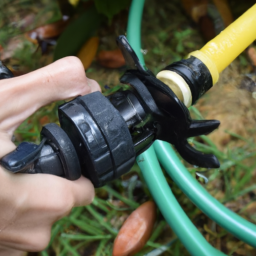How To Fix Garden Hose Spray Nozzle
How To Fix Garden Hose Spray Nozzle
How to Fix Garden Hose Spray Nozzles
When your garden hose spray nozzle has low pressure, affects the efficiency of your cleaning work. There's nothing worse than starting the task of cleaning your car or watering your garden when the water flow is weak or non-existent. Follow the steps below to fix your garden hose spray nozzle and get the job done.
Identify the Issue
The first step in fixing your garden hose spray nozzle is to identify what's causing the issue. If the nozzle is simply blocked with dirt or debris, it can be easily cleared. If the nozzle has been damaged by age or wear and tear, it may need to be replaced.
Checking for Blockages
The most common cause of obstructed flow of water in a garden hose is the presence of dirt and debris. To check for blockages, disconnect the nozzle from the hose and then remove the nozzle from the handle. Clean the outside of the nozzle, paying attention to the small grooves and slots that are located on the outside.
Clean the Inside of the Nozzle
Inspect the inside of the nozzle for any blockages and remove them. Use a thin wire to dislodge any stubborn debris or a cotton swab to wipe away dirt or grit. Many garden hose nozzles also contain a filter that can be easily removed and washed.
Inspect the O-Ring
Locate the small O-ring near the nozzle inlet and inspect it for signs of wear. If the O-ring is cracked or worn, it will need to be replaced. O-rings, seals and gaskets can be purchased from your local hardware store.
Check the Insert
If there is an insert inside the nozzle that can be removed, check to make sure it is not clogged or damaged. If the insert is clogged, clean it with a cotton swab and a small brush. If the insert is damaged, it will need to be replaced.
Replace the Nozzle
If the nozzle is severely damaged or broken, it will need to be replaced. You can find garden hose nozzles at your local garden center or home improvement store. Look for a nozzle with adjustable spray patterns.
Tighten Nozzle Connections
Check the garden hose connections to the nozzle. If the connections are loose, tighten them with a pair of pliers. Make sure the connections are secure but not overly tight. Overextended connections can lead to a weak water flow.
Test the Nozzle
Reconnect the nozzle to the hose and turn on the water. The nozzle should be able to produce a strong, steady stream of water. If the nozzle is still blocked or producing a weakened flow, repeat the steps above or replace the nozzle.
Brief Recap
Fixing your garden hose spray nozzle doesn't have to be difficult or expensive. The most common cause of low pressure in a garden hose is blockages, so first check for any debris that may be preventing water from flowing freely. If you cannot locate the blockage, inspect the O-ring, insert, and connections to the nozzle and replace if necessary. With a little bit of effort and a few simple tools, you'll have your garden hose working as good as new in no time.

Previous Page
Next Page
